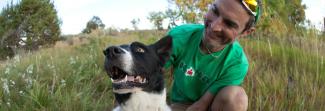About 70% of dogs over the age of three have some form of dental disease, and so it’s important to support your dog’s dental health. Dogs need tough things to chew and bite through in order to keep teeth and gums healthy. Both will otherwise deteriorate, especially if all your pet eats is soft food! So, what to do?
Gotta Have That Crunch
Be sure that your four-legged friend has crunchy things to eat. Indeed, studies have shown that consistent dental care is important to prevent tooth decay and gum disease in our canine companions [1]. The same is true for cats (good luck brushing their teeth, though...) [1].
Gnaw on This
Dental chews have been shown to reduce plaque formation in dogs, which may help prevent gum disease with regular use [2, 3]. Some dental chews may also support fresh breath with ingredients such as real mint, coconut oil, and rosemary. It’s important to always supervise your dog when he’s working on a chew bone.
Pooch Paste
So, doggie toothpaste... A Google search for “dog toothpaste” turned up over 10 million hits, so I’d say that this is a pretty hot topic! Regular brushing of your dog’s grill may improve the healing of gum disease in part by stimulating gum regrowth [4]. There are a number of commercial doggie toothpastes on the market. Try to find one that is as natural as possible (avoid those with artificial colors, for instance). Also, many contain glycerin, a petrochemical byproduct. Instead, look for those that have vegetable glycerin. Remember that your dog doesn’t necessarily like the same flavors that we do, so think liver or chicken, not wintergreen.
Absolutely do not use people toothpaste. Toothpaste for people contains ingredients that are toxic and otherwise unpleasant for dogs. Stick with a dog-specific toothpaste that can be applied with a dog-specific toothbrush, a cotton ball, or piece of cloth. Even your finger will suffice. Be careful to add water slowly so that the paste doesn’t become too watery.
Brush-a, Brush-a, Brush-a...
Start slowly and early in life as puppies to get your dog used to brushing. Be gentle, but don’t dawdle and try your dog’s patience. Always reward her with a crunchy treat afterwards. Consistency is key. According to one study, gum health was maintained only when dogs had their teeth brushed daily or when their teeth were brushed every other day and they were also given a daily dental chew [5].
Gum Infections
It’s important to take care of infections, which are usually bacterial and are indicated by red, swollen gums. The bacteria that cause gum disease can go systemic and cause dangerous infections elsewhere in the body. If the infection worsens or is severe to begin with, get your dog into the veterinarian as quickly as possible.
Dental Health Inside Out
Don’t forget to supply your dog with mineral- and vitamin-rich foods to support oral health from the inside out. Vitamin C may help prevent infections from starting in the first place by supporting immune health. For more specific guidance on supplementing your dog’s diet, see one of the books I mentioned above, and happy brushing!
Disclaimer: This information is educational in nature and is not intended as a substitute for professional medical prevention, diagnosis, or treatment.
References
[1] Buckley, C, et al (2011) The impact of home-prepared diets and home oral hygiene on oral health in cats and dogs. Br J Nutr. 106 Suppl 1:S124-7.
[2] Hennet, P (2001) Effectiveness of an enzymatic rawhide dental chew to reduce plaque in beagle dogs. J Vet Dent. 18(2):61-4.
[3] Hennet, P, et al (2006) Effectiveness of an oral hygiene chew to reduce dental deposits in small breed dogs. J Vet Dent. 23(1):6-12.
[4] Tomufuji, T, et al (2007) Location of proliferating gingival cells following toothbrushing stimulation. Oral Dis. 13(1):77-81.
[5] Gorrel, C and JM Rawlings (1996) The role of tooth-brushing and diet in the maintenance of periodontal health in dogs. J Vet Dent.13(4):139-43.

